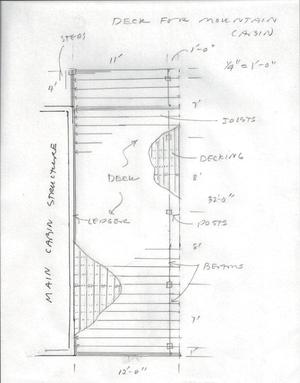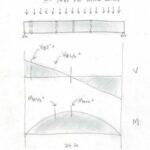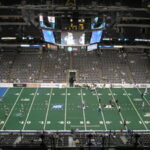DRAFT
Outline
1. Introduction
2. Shear Strength
3. Loads that Shear the Beam
4. Bending Strength
5. Loads that Break the Beam in Bending
6. Summary Loads
7. Safe Loads
8. Conclusion
9. References
1. Introduction
In our earlier lesson (here) we developed diagrams and expressions for the load on our plain concrete `Make and Break’ beam. Actually, the expressions are suitable for a reinforced beam, also, and beams of other dimensions, except that we would need to tweak the self-weight a bit. And the methods could be used generally for beams in general, both in the lab, and in practice (actual structures).
From those lessons we came away with expressions for internal loads (shear and moment) in terms of some uniformly distributed applied load, and a concentrated applied load at mid-span. We came up with those expressions in terms of `exact’ conditions for testing in the lab. For `safe’ beams we will need to incorporate Factors of Safety. Patience! They will come later.
The expressions for the `lab’ are,
V = V due to sw + V due to uniform load + V due to conc load P
V max = 166 lb + 2.58 ω applied + P applied / 2 .
M = M sw + M uniform load + M P
M max = 237 lb-ft + 4.5 ω applied ft 2 + 1.5 P applied .
Now let’s solve for the actual numbers … the uniform live load, ω applied, on the beam to break it, and / or the concentrated load, P (or P applied), at mid-span, to exactly break it. We will do this by determining the strength of the beam, and setting the strength equal to the load (load expressions above). We don’t necessarily know whether the beam will break in shear, or bending, so we will check both. And, we will also calculate `safe’ loads (ω applied or Papplied), say, if we want to use this beam for some future use. But we will wait until we look at a reinforced beam with regard to safety, as a plain concrete beam is never safe.
2. Shear Strength
We will now calculate the loads to shear the beam. We will look at two cases: 1) the uniform load ω LL, say made up of students standing on the beam, and 2) the concentrated load P. We will take these loads to not act concurrently. To do this we must first calculate the shear strength of our plain concrete beam.
From Chapter 22 of the ACI Code
Vn = (4/3) √f ‘c b h (Plain Concrete)
Where
Vn is the `nominal’ (what I call `perfect world’) shear strength,
f ‘c is the specified concrete strength,
b is the beam width, and
h is the beam depth.
Let’s say (use) 3500 psi for the compressive strength, f’c.
So,
Vn = (4/3) √3500 psi (5 in.)(11 in.);
Vn = 4338 lb.
3. Loads that Shear the Beam
Now we can set load equal to strength, and solve …
For the uniform live load …
Set Load = Strength and solve for ω applied …
V max = 166 lb + 2.58 ω applied = = 4338 lb … (note that here we let P = 0).
… ω applied = 1620 lb/ft.
Wow, this is a lot. If an average college student weighs 150 lb, then this corresponds to …
1620 lb/ft divided by 150 lb/college student = 10.8 (say, 11) college students per foot of beam … (pretty crowded).
Since we are loading 6 ft of beam, that would be W = ω L = 10.8 students per foot x 6 ft = 65 students … (the entire class!).
For the applied concentrated load P …
Now let w applied = 0.
V max = 166 lb + P / 2 = 4338 lb … (where the uniform load term is not used)
Solving for P … P = 8344 lb.
Note that 65 students are going to weigh … W = 65 (150) = 9750 lb.
So, the load is about the same, for shear, whether concentrated or distributed.
If the beam doesn’t break first, in flexure, which we will now look at.
Flexure Strength
For Chapter 22 of the ACI Code …
Mn = 5 √f ‘c S …
Where,
Mn is the `nominal’ (perfect world) bending a.k.a. flexure strength,
`5′ is a `number’ … that goes along with the √f ‘c to give us an extreme fiber rupture strength. The value 5 we could say is at the conservative end of a range of values from, say, 5 to 7.5 and greater. (Once when we added fiber reinforcement to a Plain Concrete beam and it seemed we were getting numbers closer to 7.5.) But, we’ll use the `5′. `5′ is `the Code’ (and we always obey the Code).
And f ‘c … is our specified concrete strength, and
S … is the section modulus, in this case bh2 / 6.
Using 3500 psi for √f ‘c and our dimensions of 11 in. and 5 in. …
S = (11 in.)(5 in.)2 / 6 = 45.8 in.3.
(Remember, we laid this thing like a plank, so the greater dimension is the width, not the depth, and as such, we get a pretty small S.)
So,
Mn = 5 √3500 psi x 45.8 in.3
Mn = 13,548 lb-in.
But we need it in the same dimensions as our load equation … lb-ft, so,
Mn= 13,548 lb-in. (ft/12 in.) = 1129 lb-ft.
That is flexural strength of the section.
5. Loads that Break the Beam in Flexure
To determine the loads that break the beam, we will set the load (expressions) equal to the strength (number).
For the uniform applied load …
M max, Total = 237 lb-ft + 4.5 ω applied ft 2 = 1129 lb-ft …
Solving for ω applied … ω applied = 198 lb/ft.
Or, … 198 lb/ft divided by 150 lb/student = 1.3 students per foot … or 1.3 students per ft x 6 ft = 7.9 … 8 students.
For concentrated load P …
M max, Total = 237 lb-ft + 1.5 P = 1129 lb-ft …
Solving for P … P = 595 lb.
Wow, that is not very much. (We’ll see in the lab that the thing will break before we `hardly get started’.)
6. Summary Loads
So, now let’s look at what controls.
For the uniform applied load …
It will break in shear at ω applied = 1620 lb/ft …
It will break in flexure at ω applied = 198 lb/ft … which means it will break in flexture before it breaks in shear …
So, the `controlling’ uniform live load is 198 lb/ft … flexure controls).
For the applied concentrated load P …
It will break in shear at P applied = 8366 lb … but it actually will never get there, because it will break in flexure, first, at P applied = 595 lb … flexure controls.
So, the controlling applied concentrated load P is 595 lb; flexure controls.
We have not taken the loads to act concurrently (well, except for self-weight). We could look at all kinds of combinations. Say, if the uniform load is 150 lb/ft, what concentrated load P, added to that, would break the beam? (And, would it break in shear or flexure?)
7. Safe Loads
IF we were to use these beams in some future use (structure) the building codes would require that we apply factors of safety. The numbers calculated in the section above are theoretical `exact’ (perfect world) numbers. In other words, we could only allow students that weight 150 lb each to be a part of our experiment, and we will count exactly how many there are. And we (supposedly) know the `exact’ amount of load P. But in some future situation we may have students of varying weights, and the concentrated load P, say, coming down from a column, may be carrying varying weights. So, we take into account the uncertainty of these future loads with load factors.
And, in future design situations, there are also uncertainties in our strength values. There is uncertainty in construction (dimensions, etc.); there is uncertainty in concrete strength. If we were using reinforcement there would be some reasonable uncertainties in its exact location, and so on. So, the building codes will also require us to use factors of safety with our calculated (perfect world) strength values. For plain concrete we accommodate this with strength reduction factors (denoted φ).
However, since this is a `Beam’, we cannot use Plain Concrete; the idea of safety is already addressed in that we will never have a Plain Concrete beam in a building; the beam of this conversation is only for the lab.
8. Conclusion
In this lesson we calculated the shear and bending strengths of a plain concrete beam. Then we set those values equal to expressions for load, and determined the loads that would break the beam, theoretically. We used a beam that was oriented more like a plank (`on its side’, inefficiently) and flexure controlled. We never will shear the beam – it will always break open first. And the values we obtained are …
To break the beam …
… ω applied= 198 lb ( … flexure governs)
or
… P applied = 595 lb ( … flexure governs)
NOTE that these are not concurrent; they are `either-or’.
Remember, we will make a plain concrete beam for `lab’ purposes only. Building codes do not permit us to make plain concrete beams for structures.
9. References
Building Code Requirements for Structural Concrete, ACI 318, American Concrete Institute, P.O. Box 9094, Farmington hills, Michigan, 48333.






